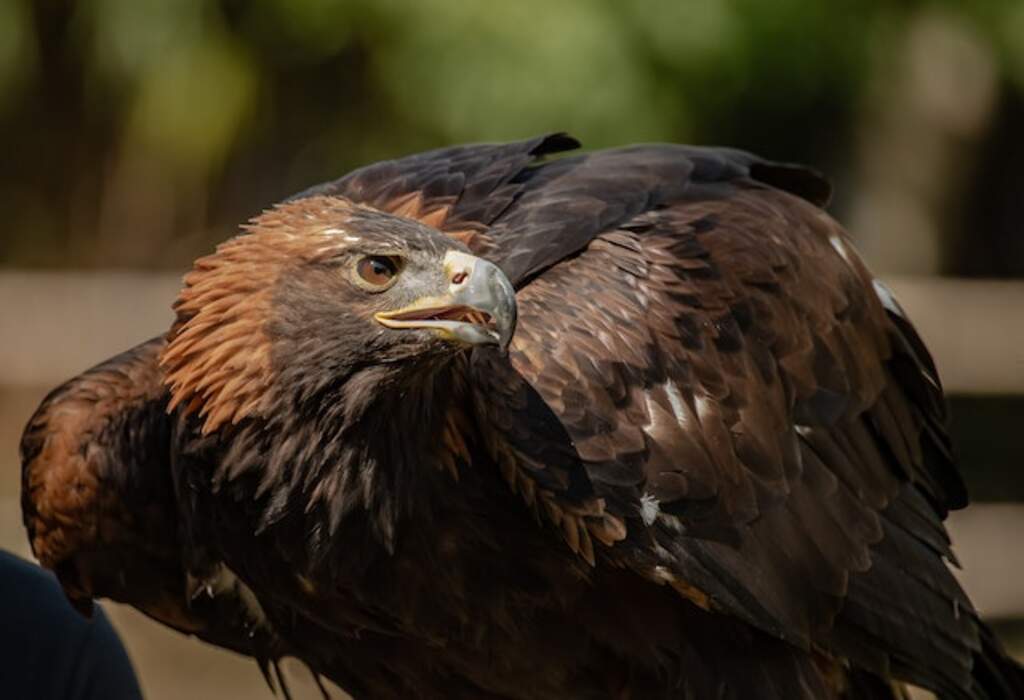Have you ever wondered if eagles have teeth? It’s a common question, given their reputation as powerful hunters. However, the answer might surprise you.
Eagles do not have teeth like humans or other animals. Instead, they rely on their beaks, which are specially adapted for hunting, eating, and defense.
In this article, we’ll delve into the anatomy of an eagle’s beak and explore how these magnificent birds have evolved unique adaptations to thrive without traditional teeth.
Table of Contents
- 1 Key Takeaways:
- 2 Do Eagles Have Teeth
- 3 The Anatomy of an Eagle’s Beak
- 4 Do Birds Have Teeth?
- 5 The Dental Structure of Eagles
- 6 The Function of an Eagle’s Beak
- 7 How Eagles Hunt and Feed
- 8 The Unique Adaptations of Eagles
- 9 Comparing Eagle Beaks to Teeth
- 10 Evolutionary History of Beaks
- 11 Additional Adaptations for Feeding
- 12 The Significance of Eagle Beaks
- 13 Conclusion
- 14 FAQs: Do Eagles Have Teeth!
- 14.1 What is the anatomy of an eagle’s beak?
- 14.2 Do birds have teeth?
- 14.3 What is the dental structure of eagles?
- 14.4 What is the function of an eagle’s beak?
- 14.5 How do eagles hunt and feed?
- 14.6 What are the unique adaptations of eagles?
- 14.7 How do eagle beaks compare to teeth?
- 14.8 What is the evolutionary history of beaks?
- 14.9 Are there any additional adaptations for feeding?
- 14.10 What is the significance of eagle beaks?
- 15 Author
Key Takeaways:
- Eagles do not have teeth, but instead use their beaks for hunting and feeding.
- An eagle’s beak is a specialized, multi-purpose tool that serves various functions, including tearing flesh and preening feathers.
- Through evolution, birds have developed specialized beak shapes to suit their specific diet and hunting style, demonstrating the importance of beaks in their survival and ecological roles.

Do Eagles Have Teeth
Eagles lack teeth in their beaks, unlike some other birds. Their beaks are powerful and sharp, aiding in capturing and tearing prey. They rely on their strong beaks and talons to grip and consume food.
This specialized adaptation suits their carnivorous diet and impressive hunting prowess, allowing eagles to thrive as skilled predators in their natural habitats.
The Anatomy of an Eagle’s Beak
Have you ever wondered why eagles don’t have teeth? Unlike humans and many other mammals, birds, including eagles, lack teeth in their mouths. But that does not mean they cannot effectively hunt and consume prey. The beak of an eagle serves many purposes and is a crucial tool for its survival.
| Part of the Beak | Function |
|---|---|
| Cere | The fleshy area at the base of the beak that protects the nostrils. |
| Hooked Tip | Used for ripping and tearing prey apart. |
| Upper Mandible | Used to catch and hold prey. |
| Serrated Edge | Helps eagles to grip onto slippery prey. |
The beak of an eagle is a multipurpose tool. It functions as a pair of scissors, ripping apart prey with ease. The cere, a soft, fleshy area located at the base of the beak, protects the nostrils from debris while the eagle is hunting.
The hooked tip of the beak is used to rip and tear apart prey. The upper mandible is used to catch and hold onto prey, while the serrated edge helps the eagle to grip onto slippery prey.
Eagles have evolved to have specialized beaks for their specific hunting and feeding needs. The beak strength and shape of an eagle are adapted to the type of prey they hunt.
For instance, the beak of a Golden Eagle is shaped like a hook, which helps them catch and tear apart larger prey like rabbits or hares.
Their strong beaks help them to break the bones of their prey and tear apart the flesh of the animal.
The Beak vs Teeth
While teeth may seem like a preferable option for hunting and consuming prey, the beak of an eagle has its advantages.
It allows for greater precision and control while hunting, as eagles can use their beaks to manipulate prey into a position that is easier for them to tear apart.
Additionally, the beak is a much lighter adaptation than teeth would be, allowing for increased mobility and agility while hunting.
“The beak of an eagle serves many purposes and is a crucial tool for its survival.”
However, the beak lacks the crushing power of teeth and may not be as effective against hard-shelled prey like turtles or tortoises.
For this reason, eagles have evolved to develop specialized hunting techniques to suit their beak-centric structure.
For instance, some eagle species will drop their prey from a great height to crack open the shell.
In summary, while eagles do not have teeth, their beaks serve many of the same functions, and they have evolved to be effective hunters and predators without them.
Their beaks are a perfect adaptation to their diets and hunting styles, allowing them to tear apart prey with ease and precision.

Do Birds Have Teeth?
Like humans, many animals have teeth to aid in the breakdown of food. However, when it comes to birds, the story is a little different. Unlike mammals, birds do not have teeth in their mouths.
While some bird species, such as the extinct giant bird Gastornis, have been known to possess teeth in the past, the vast majority of birds have evolved alternative adaptations to suit their feeding habits.
This adaptation is primarily due to the lightweight nature of birds and the need to keep their weight to a minimum for efficient flight.
Teeth, which are dense and heavy, would be counterproductive to this goal. Instead, birds have evolved specialized beaks to aid in the efficient capture, handling, and consumption of food.
While birds may not have teeth, they have adapted their beaks to fit a range of feeding styles and prey.
For example, woodpeckers have long, pointed beaks that enable them to probe wood for insects, while kingfishers have long, narrow beaks to help them catch fish.
Eagles, on the other hand, have strong, curved beaks that enable them to tear apart flesh for consumption.
Overall, while birds do not possess teeth, their beaks have evolved to be just as effective in aiding them with feeding and survival.
The Dental Structure of Eagles
Unlike mammals, eagles do not have teeth. Instead, they rely on their powerful beaks to capture, kill, and tear apart prey. The beak is composed of a hard keratin material, similar to that of our fingernails and hair.
The upper and lower parts of the beak are not fused together, allowing them to move independently and increase the eagle’s dexterity.
The sharp edges of the beak are used to slice through flesh, while the hooked tip is used to tear it apart.
Additionally, the base of an eagle’s beak is lined with a series of sharp projections called tomial teeth. These teeth help the eagle grip onto prey and prevent it from slipping away during feeding.
Despite the lack of traditional teeth, the beak of an eagle is a formidable weapon.
Its sharpness and strength allow it to easily split open the tough hides and shells of prey, making it a highly efficient and effective tool for survival in the wild.
The Function of an Eagle’s Beak
The beak of an eagle is a remarkable tool that serves a multitude of functions. Its most obvious use is for hunting and tearing flesh from prey.
The sharp, curved shape of the beak allows eagles to grasp and kill prey with precision and control.
Unlike teeth, the beak can also be used for preening feathers, removing parasites, and scratching an itch. A healthy beak is crucial for an eagle’s survival.
The shape and size of an eagle’s beak are crucially adapted to suit their specific hunting style and prey.
For example, fish-eating eagles have hooked beaks that allow them to grip slippery prey, while eagles that hunt small mammals have beaks that are more pointed and powerful, allowing them to deliver a deadly bite.
Another important function of an eagle’s beak is to aid in feeding. After capturing prey, eagles use their beaks to tear apart the flesh and pick out bones or other unwanted material.
The beak is also used to manipulate food in the mouth, pushing it towards the throat for swallowing.
Overall, the beak of an eagle is a highly specialized and valuable tool that enables them to thrive in their natural environments.
Its multiple functions make it an essential component of their survival and highlight the remarkable adaptations of eagles.

How Eagles Hunt and Feed
Eagles are apex predators in their habitats, preying on a variety of animals, including fish, mammals, and birds. Their hunting style is versatile, and largely depends on their prey.
Eagles typically prefer live prey and will use their sharp talons to catch and immobilize their target. Once caught, they use their powerful beak to tear apart the flesh and feed on the meat.
Some eagle species, such as the bald eagle, are known for their fishing skills. They will use their sharp talons to dive into the water and catch fish, using their beaks to maintain their grip on the slippery prey.
Most eagle species will also scavenge on carcasses, using their strong beak to rip apart flesh and feed on the remains.
Eagles have a unique digestive system, which allows them to process and extract essential nutrients from their prey.
Their stomach acids are strong enough to dissolve bone, allowing them to digest even the tougher parts of their prey.
How Eagles Use Their Beaks for Hunting
Eagles use their beaks in various ways during the hunting process. The sharp edges of their beaks allow for precise and controlled movements, which is essential when hunting agile prey such as rabbits or birds.
The shape and size of an eagle’s beak will vary based on its diet. Eagles that hunt larger prey, such as Arctic foxes or mountain goats, will have larger and stronger beaks to deal with the tougher flesh.
When hunting, eagles will use their beak to grab onto their prey and hold it in place.
They will then use their talons to deliver the killing blow, piercing the prey’s vital organs. Finally, the eagle will use its beak to tear apart the flesh and feed on the meat.
Overall, the powerful beak of an eagle is a critical tool in its hunting and feeding process, allowing it to survive in its environment and maintain its position as an apex predator.
The Unique Adaptations of Eagles
Eagles are one of the most fascinating bird species in the world. They have evolved unique adaptations that contribute to their success in hunting, feeding, and surviving in different environments.
While the absence of teeth in their beaks is often the most notable difference, eagles possess a range of specialized adaptations that compensate for this absence.
Eagle eyesight: Eagles have remarkable eyesight that allows them to spot prey from great distances.
Their eyes are designed to perceive color and detail exceptionally well, which helps them to identify potential prey and avoid danger.
Eagle talons: Eagles have strong and powerful talons that are specially adapted for catching and holding prey. The talons are curved, sharp, and strong enough to penetrate through flesh and bone, making them effective weapons for capturing prey.
Eagle digestive system: Eagles have a unique digestive system that allows them to break down and extract nutrients from a wide range of prey. Their stomachs produce strong acids that can dissolve bones and other indigestible parts, allowing them to extract the maximum amount of nutrients from their food.
Eagle beak adaptations: While the absence of teeth is a significant difference between eagles and other animals, their beaks have evolved specialized adaptations that compensate for this. The sharpness and curvature of the beak allows eagles to tear apart prey efficiently, and the size and shape of the beak are adapted to their specific hunting styles and diets.
Overall, eagles are a remarkable bird species that have developed unique adaptations to thrive in diverse environments. The combination of their keen eyesight, powerful talons, specialized digestive system, and unique beak adaptations makes them formidable hunters and vital contributors to their ecosystems.

Comparing Eagle Beaks to Teeth
While many animals have evolved to have teeth for capturing and consuming prey, eagles have developed a unique adaptation with their beaks. So how does the power of an eagle’s beak compare to that of teeth?
One advantage of an eagle’s beak is its precision and control. The shape and size of the beak are adapted to the specific diet and hunting style of the eagle, allowing for greater accuracy when capturing prey.
Additionally, the beak can also be used for preening feathers and other tasks.
However, the absence of teeth means that eagles lack the crushing power that teeth provide. While the beak can tear apart flesh efficiently, it cannot crush bones or other tough materials that teeth are capable of handling.
Overall, the beak versus teeth debate is one of trade-offs. While teeth offer crushing power, the beak offers greater precision and control.
For eagles, their powerful beaks have proven to be a successful adaptation for hunting and feeding, compensating for the lack of teeth in their dental structure.
Evolutionary History of Beaks
The beak plays a critical role in the feeding and survival of birds, and the evolution of this structure has been shaped by environmental and dietary factors.
The earliest birds, such as Archaeopteryx, had beaks that were similar to those of reptiles, with sharp teeth and a long snout.
Over time, as birds evolved to occupy new ecological niches, their beaks diversified into various shapes and sizes to help them catch and consume a wide range of prey.
One of the most significant drivers of beak evolution in birds is diet. For example, seed-eating birds, such as finches and sparrows, have evolved short, thick beaks that are adapted for crushing seeds.
Birds that feed on nectar, such as hummingbirds, have long, narrow beaks that allow them to probe deep into flowers to extract nectar.
Waterfowl, such as ducks and geese, have broad and flat beaks that help them filter small organisms from the water.
Other factors that have shaped beak evolution in birds include habitat, social behavior, and competition for resources.
Some birds, such as woodpeckers and toucans, use their beaks for excavating nests and burrows in trees, while others, such as penguins and cormorants, have developed streamlined beaks for efficient swimming and diving.
Additional Adaptations for Feeding
While eagles are known for their powerful beaks, other bird species have developed specialized beak shapes to adapt to their diets and feeding habits. These adaptations are crucial in ensuring their survival in their respective habitats.
One example is the probing beak of nectar-feeding birds, which is long and slender to reach deep into flowers to extract nectar.
The beaks of seed-eating birds, on the other hand, are strong and thick, allowing them to crack open shells and husks.
Some bird species have even developed unique feeding techniques that require specialized beak adaptations.
For instance, the spoonbill’s beak is shaped like a spoon, which it uses to sift through mud and shallow water to catch small aquatic creatures.
The flamingo’s beak is also curved downwards, with a serrated edge that it uses to filter out small crustaceans and plankton from the water.
In addition to beak shape, some birds have also evolved unique feeding behaviors. Pelicans, for example, are known for their impressive plunging dives to catch fish.
They have a pouch attached to their beak, which they use as a scoop to collect fish from the water.
Overall, the diversity of beak shapes and feeding behaviors in the bird world is a testament to the incredible adaptability and resilience of these creatures.

The Significance of Eagle Beaks
Eagle beaks are a vital part of their survival in the wild. As we have discussed, eagles do not possess teeth but rely on their strong and sharp beaks for hunting and feeding.
The beak’s structure allows for precision and control during hunting, while its sharpness and strength enable the bird to tear apart prey efficiently.
But eagles’ beaks are not just powerful hunting tools; they also contribute to the ecological balance of ecosystems.
By controlling prey populations, eagles help to maintain the balance of various animal and plant species in their environment.
Eagles have evolved a wide range of adaptations, from keen eyesight to powerful talons and specialized digestive systems, that compensate for the absence of teeth and make them successful predators.
Understanding the significance of eagle beaks helps us appreciate the remarkable adaptations of these birds and their role in maintaining thriving ecosystems.
Conclusion
In conclusion, it is clear that eagles do not have teeth, relying instead on their specialized beaks for hunting, feeding, and survival.
The anatomy of an eagle’s beak serves as a multipurpose tool, allowing them to tear apart prey efficiently and preen their feathers.
While some bird species do possess teeth, most birds, including eagles, have evolved alternative adaptations to suit their feeding habits.
The unique dental structure of eagles, highlighting the sharpness and strength of their beaks, allows them to capture and consume live prey.
Their other adaptations, such as keen eyesight, powerful talons, and specialized digestive systems, compensate for the absence of teeth and contribute to their hunting and feeding success.
Comparing eagle beaks to teeth, it is evident that the beak allows for greater precision and control while hunting, but lacks the crushing power of teeth.
However, the evolutionary history of beaks in birds has shown how different bird species have developed specialized beak shapes to adapt to their specific diets and environments.
Overall, the significance of eagle beaks is clear in their survival and ecological roles. Their powerful beaks contribute to maintaining the balance of ecosystems by controlling prey populations.
The remarkable adaptations of eagles that allow them to thrive without traditional teeth are a testament to the ingenuity and adaptability of the natural world.

FAQs: Do Eagles Have Teeth!
What is the anatomy of an eagle’s beak?
An eagle’s beak is a multipurpose tool used for hunting, feeding, and self-defense. It does not have teeth, but is sharp and strong.
Do birds have teeth?
While some bird species have teeth, most birds, including eagles, do not possess teeth. They have evolved alternative adaptations to suit their feeding habits.
What is the dental structure of eagles?
Eagles do not have teeth, but have a unique beak structure that is adapted for tearing apart prey efficiently.
What is the function of an eagle’s beak?
An eagle’s beak serves various functions, including hunting, tearing flesh, and preening feathers. Its shape and size are specifically adapted to their diet and hunting style.
How do eagles hunt and feed?
Eagles use their beaks as essential tools in capturing and consuming prey. They prefer live prey and tear it apart using their sharp beaks.
What are the unique adaptations of eagles?
Eagles have other adaptations such as keen eyesight, powerful talons, and a specialized digestive system that compensate for the absence of teeth.
How do eagle beaks compare to teeth?
Eagle beaks offer greater precision and control while hunting but lack the crushing power of teeth.
What is the evolutionary history of beaks?
Beaks in birds have evolved differently in various species to suit their specific diets and environments.
Are there any additional adaptations for feeding?
Different bird species have developed beak shapes that vary depending on their food sources, such as probing beaks for nectar-feeding birds or shredding beaks for seed-eating birds.
What is the significance of eagle beaks?
Eagle beaks play a vital role in the survival and ecological balance of ecosystems by controlling prey populations.



